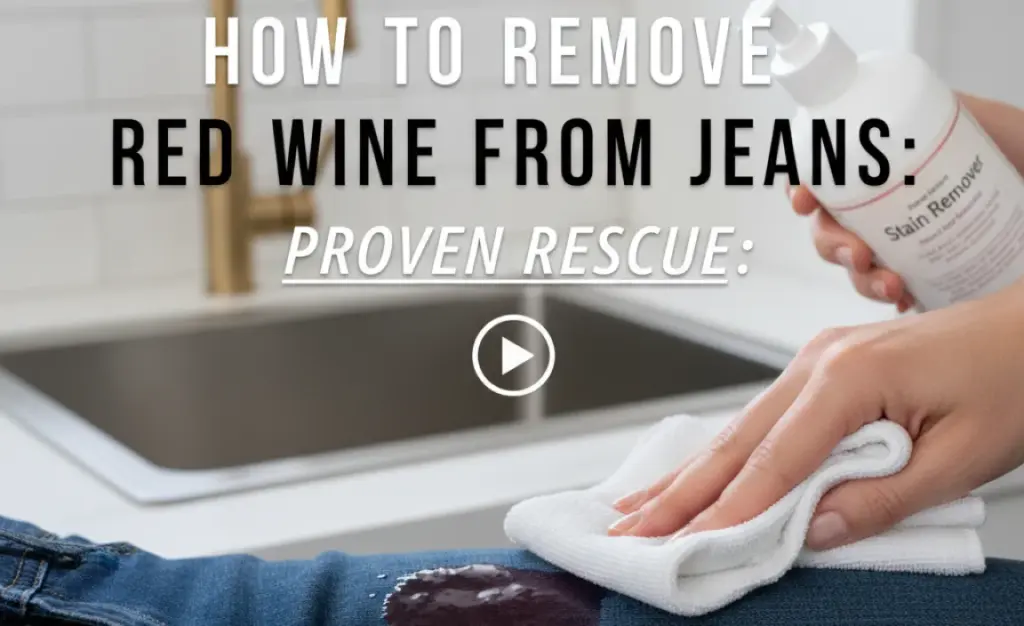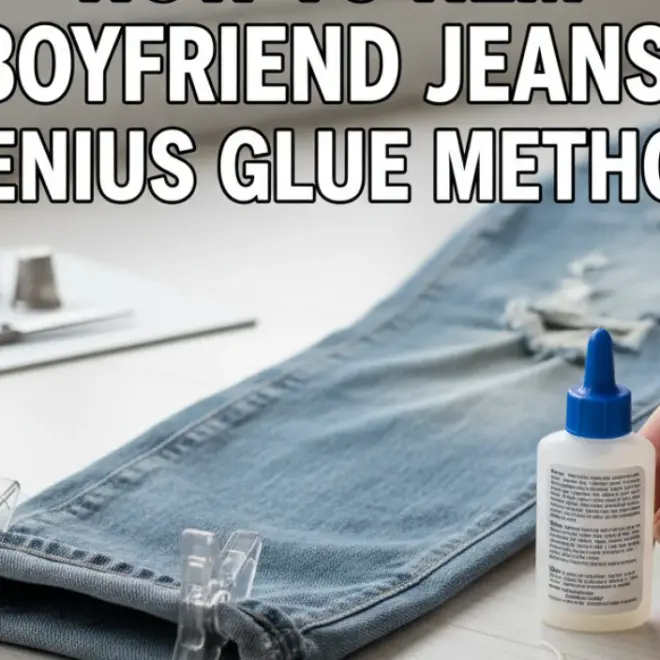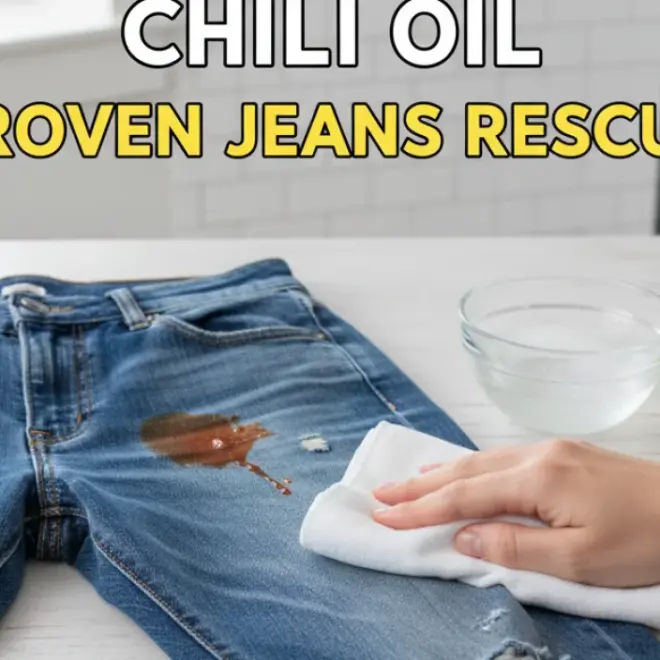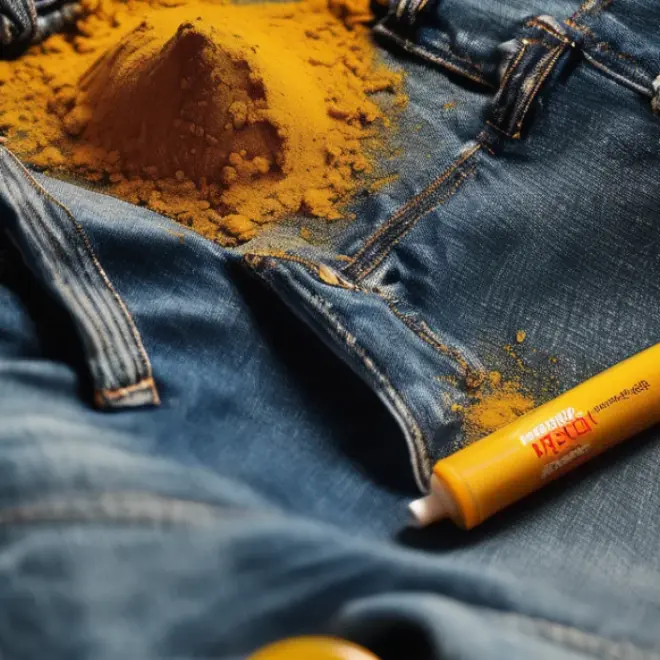Yes, you can remove red wine stains from your favorite jeans! Acting fast and using common household items like salt, dish soap, or club soda can effectively lift fresh spills. Even older stains can often be rescued with a bit of patience and the right stain removers.
Spilled red wine on your jeans can feel like a fashion emergency. Those vibrant ruby hues seem determined to become a permanent part of your denim. But don’t despair! Many a great pair of jeans has been saved from this common mishap. With the right approach, you can often rescue your denim and keep your favorite pair looking as good as new. This guide will walk you through effective methods, from immediate action to tackling tougher, older stains, so you can confidently tackle that dreaded wine spill.
Immediate Rescue: Acting Fast on Fresh Red Wine Stains
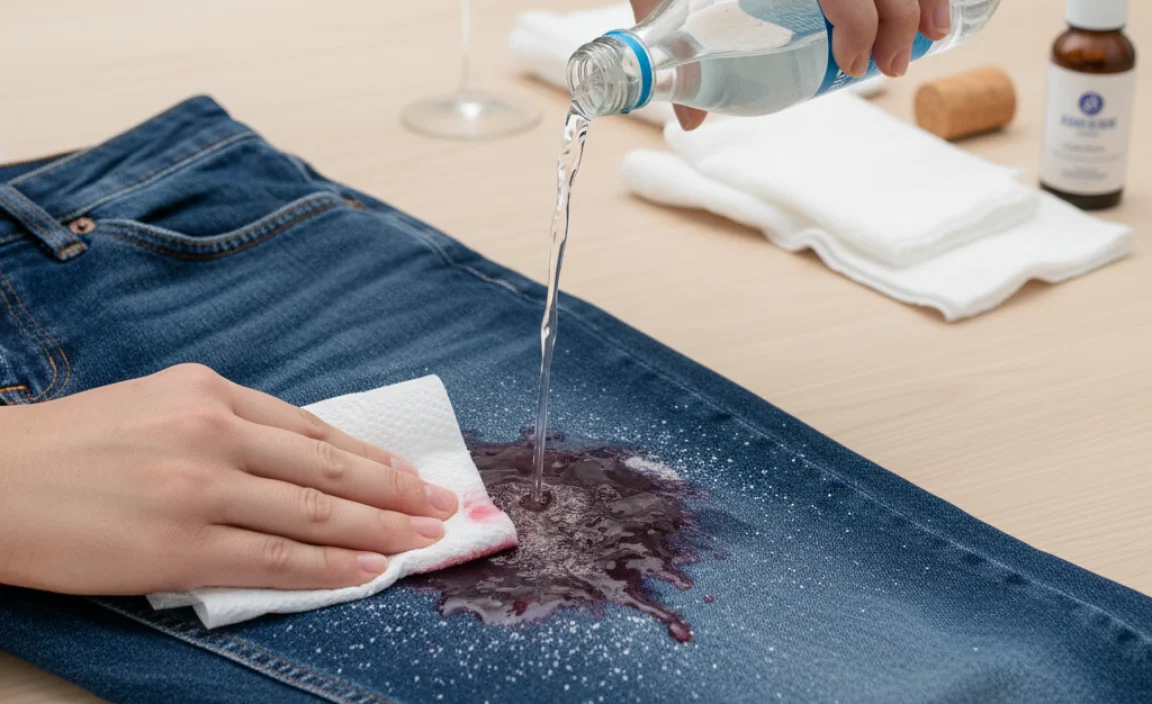
The key to conquering a red wine stain on denim is speed. The sooner you can treat the stain, the easier it will be to remove. Fresh stains haven’t had time to set deep into the fabric fibers, giving you the best chance for a complete rescue.
Blot, Don’t Rub!
Your very first instinct might be to rub the stain. Resist this urge! Rubbing will push the wine deeper into the denim fibers and spread the stain, making it much harder to remove. Instead, grab a clean, white cloth or paper towels and gently blot the stained area. Work from the outside of the stain inward to prevent spreading.
The Power of Salt or Baking Soda
These common kitchen staples are surprisingly effective at absorbing liquid and lifting stains. They work by drawing the wine out of the fabric.
What you’ll need:
- Clean cloths or paper towels
- Table salt or baking soda
- A pre-wash stain remover or liquid laundry detergent
- Cold water
Steps:
- Blot: As mentioned, gently blot up as much excess wine as possible with a clean cloth or paper towel.
- Cover: Generously cover the entire stained area with a thick layer of salt or baking soda. You want enough to absorb all the visible moisture.
- Let it sit: Allow the salt or baking soda to sit on the stain for at least 15-30 minutes, or even for a few hours if you have the time. You’ll see it start to turn pink as it absorbs the wine.
- Scrape/Brush: Once the absorbent has done its job, gently scrape or brush off the salt or baking soda.
- Pre-treat: Apply a pre-wash stain remover directly to the remaining stain or rub a small amount of liquid laundry detergent into the area. Let this sit for about 5-10 minutes.
- Rinse: Rinse the treated area with COLD water. Hot water can set stains, so always use cold for initial rinsing.
- Wash: Wash the jeans as usual with your regular detergent, but check the stain BEFORE putting them in the dryer.
- Dry: If the stain is gone, you can air dry or machine dry as usual. If any trace of the stain remains, repeat the process or try another method. Never machine dry a stained garment, as the heat will permanently set the stain.
Club Soda Solution
The carbonation in club soda can help lift stains. It’s a good option if you don’t have salt or baking soda immediately available.
What you’ll need:
- Club soda
- Clean cloths or paper towels
- Cold water
Steps:
- Blot: Blot up excess wine gently.
- Saturate: Pour a small amount of club soda directly onto the stain.
- Blot again: Continue blotting with a clean cloth. The club soda should help lift the color.
- Rinse: Rinse the area with cold water.
- Pre-treat & Wash: Follow steps 5 through 7 from the salt/baking soda method.
Tackling Tougher Stains: When Time Isn’t on Your Side
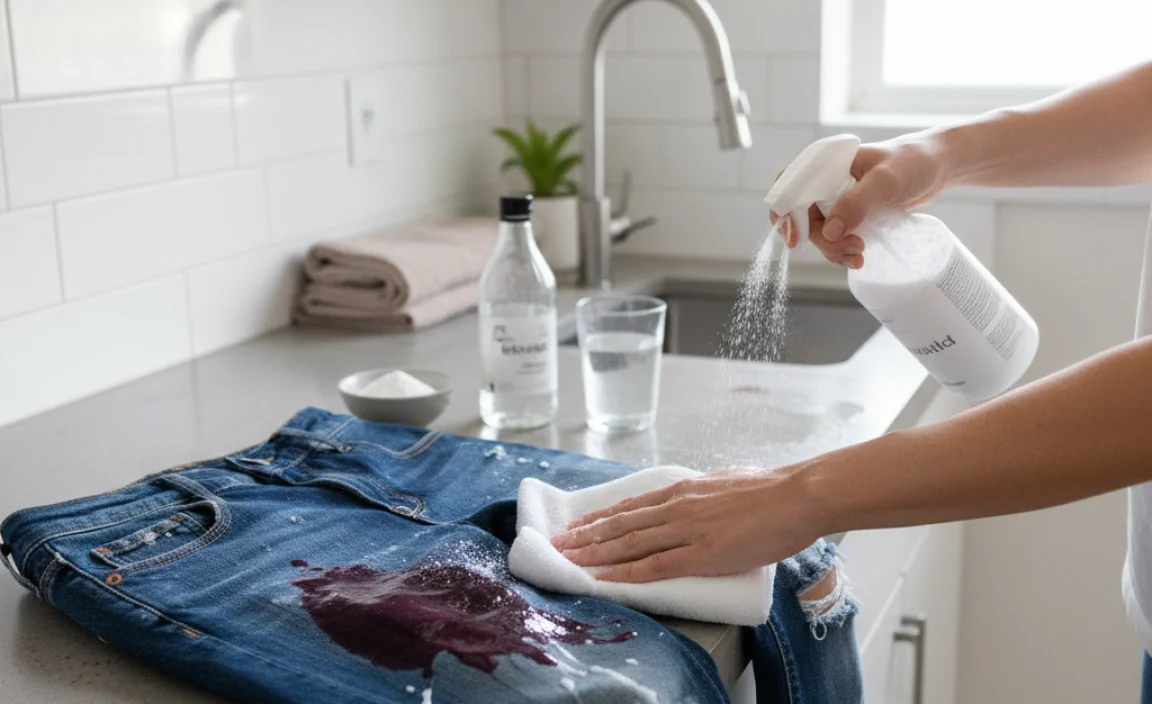
If the wine stain has had a chance to dry or if initial treatments haven’t completely removed it, you’ll need to employ slightly stronger methods. The principle remains the same: break down the stain and lift it from the fabric.
Dish Soap and Hydrogen Peroxide Combo
This is a popular and effective DIY approach for red wine stains. Dish soap helps break down the stain particles, and hydrogen peroxide acts as a mild bleach. Be cautious, as hydrogen peroxide can slightly lighten some darker fabrics if left on too long, so always do a patch test on an inconspicuous area first.
What you’ll need:
- Liquid dish soap (clear or blue is best, avoid colored ones)
- 3% hydrogen peroxide
- Clean cloths or paper towels
- Cold water
Steps:
- Mix: In a small bowl, mix equal parts liquid dish soap and 3% hydrogen peroxide. A 1:1 ratio is a good starting point.
- Apply: Gently dab the mixture onto the stain using a clean cloth or cotton ball. Work from the outside in.
- Let it dwell: Allow the mixture to sit on the stain for 5-30 minutes, depending on the severity of the stain. Keep an eye on it.
- Rinse: Thoroughly rinse the treated area with cold water.
- Pre-treat & Wash: Apply a pre-wash stain remover or liquid laundry detergent to any remaining discoloration. Let it sit, then wash the jeans in cold water with your regular detergent.
- Check and repeat: Inspect the jeans after washing before drying. If the stain is still visible, repeat the process.
For a more stubborn stain, you might consider a commercial stain remover specifically designed for red wine or tough stains. Look for products containing enzymes or oxygen-based cleaners. Always follow the product’s instructions carefully.
White Vinegar for Stubborn Spots
White vinegar is acidic and can help break down red wine pigments. It’s a safe option for most colorfast fabrics.
What you’ll need:
- White vinegar
- Water
- Liquid laundry detergent
- Clean cloths
Steps:
- Mix: Mix equal parts white vinegar and water.
- Apply: Dampen a clean cloth with the vinegar-water solution and blot the stain.
- Let it sit: Allow the solution to work on the stain for about 10-15 minutes.
- Rinse: Rinse with cold water.
- Wash: Pre-treat with liquid detergent or a stain remover, then wash as usual in cold water.
Choosing the Right Tools for the Job
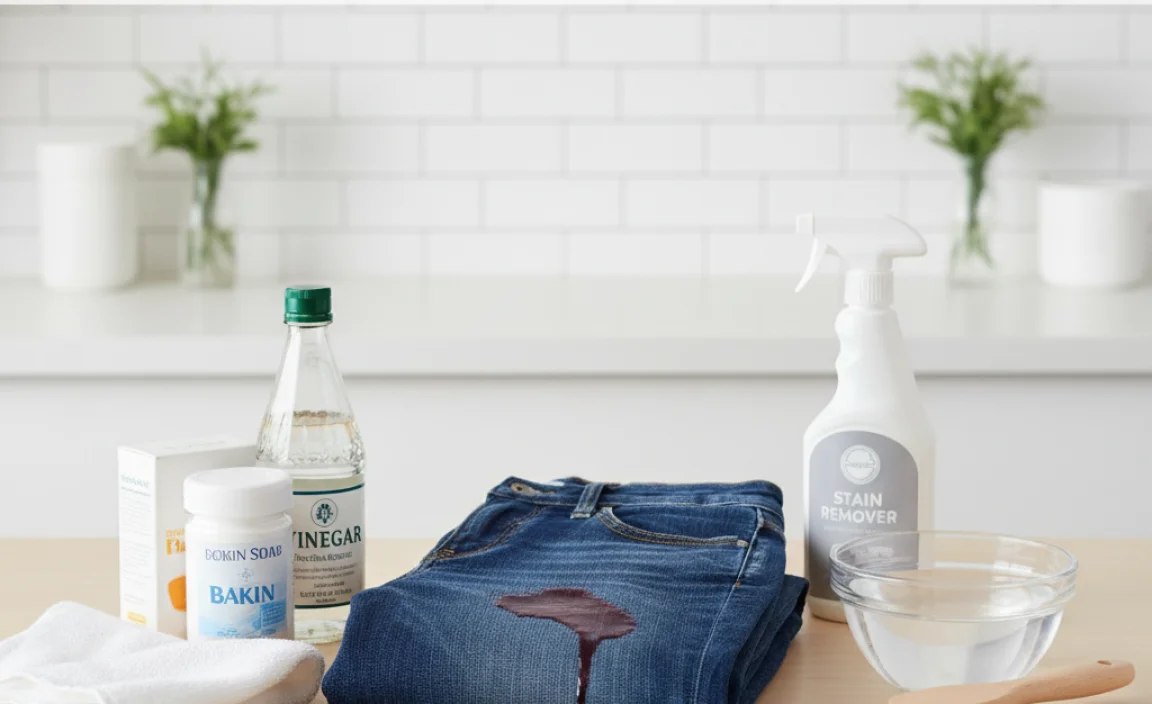
Having the right supplies on hand can make the difference between a salvageable stain and a ruined pair of jeans. Here’s a breakdown of common items that are incredibly useful:
| Item | Purpose | Why it Works | Considerations |
|---|---|---|---|
| Salt (Table or Kosher) | Absorbent, Stain Lifting | Draws moisture and pigment out of fabric fibers. | Best for fresh stains. Can leave residue if not fully rinsed. |
| Baking Soda | Absorbent, Mild Abrasive | Absorbs liquid and helps to lift light stains. | Similar to salt; best for immediate treatment. |
| Club Soda | Liquid Lifting | Carbonation helps to lift the stain from the fabric. | Good for minor fresh spills when other items aren’t available. |
| Liquid Dish Soap | Degreaser, Stain Breakdown | Breaks down organic compounds and lifts grease and pigment. | Use clear or blue-tinted to avoid adding color. Crucial in the H2O2 mix. |
| 3% Hydrogen Peroxide | Mild Bleaching Agent | Oxidizes and breaks down color molecules in the stain. | Must be tested on an inconspicuous area first, can lighten fabrics. Use 3% solution only. |
| White Vinegar | Acidic Cleaner | Helps to dissolve and lift red wine pigments. | Generally fabric-safe, but a patch test is wise; can have a mild odor that washes out. |
| Commercial Stain Remover | Targeted Stain Removal | Formulated with enzymes or oxygen boosters to break down specific stain types. | Choose one for red wine or protein/tannin stains. Always follow instructions. |
| Clean White Cloths/Paper Towels | Blotting, Application | Essential for absorbing excess liquid and applying treatments without transferring color or lint. | Always use white to avoid accidental color transfer. |
What About Older, Dried Red Wine Stains on Jeans?
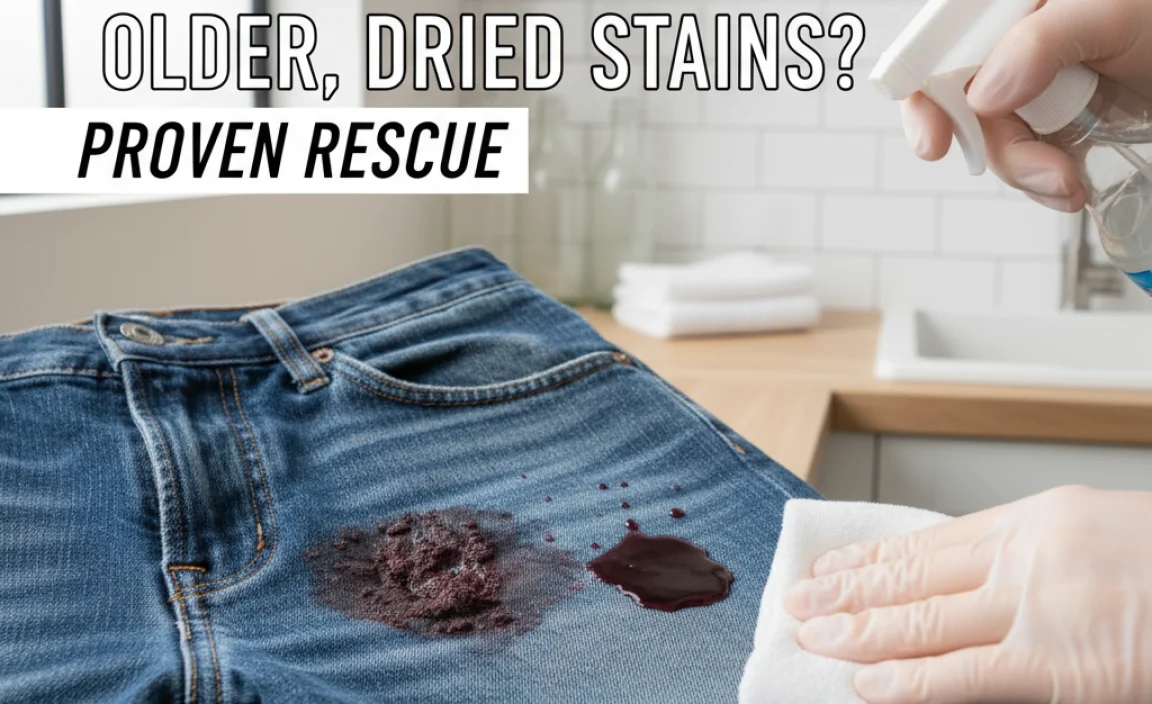
Dried red wine stains are more challenging because the pigment has had time to bond with the denim fibers. However, they are not necessarily permanent. You’ll likely need a more robust approach, and multiple tries might be necessary.
Enzyme-Based Cleaners
Many commercial stain removers use enzymes designed to break down organic stains like wine. These can be very effective on dried stains. Follow the product’s instructions carefully, which often involves applying the cleaner, letting it sit for an extended period (sometimes hours), and then washing.
Oxygen Bleach (Color-Safe Bleach)
Unlike chlorine bleach, oxygen bleach (often containing sodium percarbonate) is designed to be safer for colors. It works by releasing oxygen when mixed with water, which helps to lift and break down stains. Products like OxiClean or generic versions are widely available. Always follow the package directions for soaking or pre-treating.
How to use oxygen bleach for soaking:
- Find a basin or sink large enough to fully submerge the stained part of your jeans.
- Fill with cool or lukewarm water.
- Add the recommended amount of oxygen bleach for soaking (check the product packaging).
- Stir to dissolve the powder.
- Submerge the stained jeans, ensuring the entire stained area is underwater.
- Let the jeans soak for several hours, or even overnight for very stubborn stains.
- Check the stain periodically.
- After soaking, rinse the jeans thoroughly.
- Wash the jeans as usual with your regular detergent.
- Inspect for stain removal before drying. If needed, repeat the soak or try another method.
For more information on stain removal, the Cleanipedia guide offers further expert tips on various stain scenarios.
Consider Professional Cleaning Advice
If your jeans are particularly delicate, very expensive, or the stain is extensive and old, you might consider consulting a professional dry cleaner. They have access to specialized cleaning agents and techniques that might be beyond home use. When taking them in, be sure to point out the stain and mention what caused it and what you’ve already tried.
Important Considerations and What to Avoid
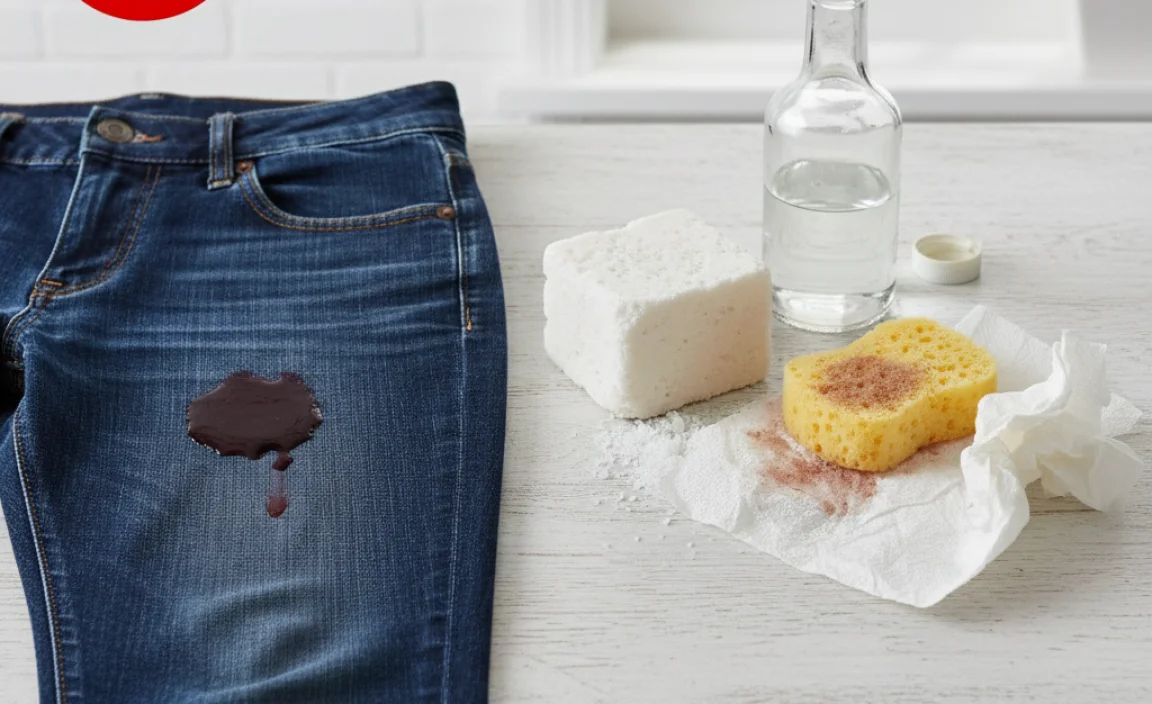
Water Temperature is Crucial
Always use COLD water when treating red wine stains, especially in the initial stages. Hot water can cause the stain to bond with the fabric fibers, making it much harder, if not impossible, to remove. Save hot water for the final wash cycle only if you are absolutely certain the stain has been fully removed.
Test First!
Before applying any cleaning solution (especially hydrogen peroxide or commercial stain removers) to the main stain, test it on an inconspicuous area of the jeans, such as an inside seam or hem. This ensures the solution won’t damage the color or fabric.
Avoid the Dryer Until the Stain is Gone
This is a critical rule. The heat from a clothes dryer will permanently set any remaining stain. Always air dry your jeans after treatment and wash. If you inspect them after an air dry and the stain is gone, you can then machine dry them if desired. If the stain persists, it’s easier to re-treat a damp garment than a heat-set one.
Know Your Denim
While most denim is sturdy, some specialty washes or blends might be more sensitive. If your jeans have a distressed finish, a unique dye, or are made from a delicate fabric blend, exercise extra caution. Stick to gentler methods like salt or mild detergent first.
Frequently Asked Questions about Removing Red Wine Stains from Jeans
Q1: How fast do I need to treat a red wine stain on jeans?
A: As soon as possible! Fresh stains are much easier to remove than dried ones. Blotting immediately and applying an absorbent like salt can make a huge difference.
Q2: Can I use bleach on red wine stains on my jeans?
A: Chlorine bleach is generally NOT recommended for colored denim as it can remove the dye and damage the fabric. Use a color-safe oxygen bleach if you need a stronger treatment for dried stains, but always test it first.
Q3: My red wine stain is old and dried. Is there any hope?
A: Yes, there’s always hope! Older stains require more patience and potentially stronger treatments like enzyme-based cleaners or oxygen bleach soaks. You may need to repeat a method a few times.
Q4: What’s the best thing to do if I spill red wine on my jeans right now?
A: Blot up as much as you can with a clean cloth or paper towel. Then, generously sprinkle the stain with table salt or baking soda. Let it absorb the wine for at least 30 minutes, then gently brush it off and proceed with a cold water rinse and pre-treatment.
Q5: Will using salt damage my jeans?
A: No, salt is a safe household item for most denim fabrics. It acts as an absorbent and helps lift the stain. Just make sure to rinse thoroughly to remove any salt residue after treatment.
Q6: Can I use dish soap directly on the stain?
A: Yes, a small amount of liquid dish soap can be applied directly to the stain, especially after initial blotting and rinsing. It’s particularly effective when mixed with hydrogen peroxide for tougher stains.
Q7: How do I prevent red wine stains from setting permanently?
A: The absolute best prevention is to treat the stain immediately and to NEVER put the jeans in the dryer if any trace of the stain remains. Air drying is your friend until you are sure the stain is completely gone.
Conclusion
Dealing with a red wine stain on your favorite jeans can be stressful, but it’s often a manageable situation. By understanding the principles of stain removal—acting quickly, blotting instead of rubbing, and using the right household or commercial products—you can significantly increase your chances of a successful rescue. Remember to always use cold water during treatment and to avoid the dryer until you’re certain the stain is gone. With a little perseverance and the methods outlined above, your denim can be back to its pre-spill glory, ready for whatever adventures come next.


